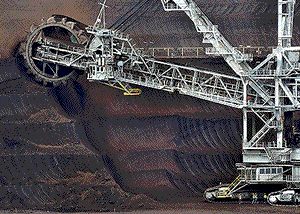Brown coal is plentiful in the Gippsland region of Victoria, easy and cheap to access. The brown coal at Gippsland is relatively free of sulfur and nitrogen and produces less than 5% by weight of ash.
However, it is composed of 60% water and as such is considered a low grade fuel.
Black coal is many millions of years older than brown coal and has a lower water content. Black coal has a heat content of approximately 35300 kJ/kg where as brown coal has a heat content of approximately 28470 kJ/kg, depending on the water content.

Unlike black coal, brown coal must be dried before it is burnt. If water is allowed to enter the furnace it will lower the temperature of the furnace and severely curb its ability to produce high temperature steam to drive the turbines. Click to see how electricity is produced at a coal fired power station.
Water has a very high specific heat capacity of 4.18 J/g/oC. That is to say that one gram of water absorbs 4.18 J of heat energy before it rises by 1oC. That is a great deal of heat energy just going into heating water in the furnace rather than increasing the temperature of the walls of the furnace. As such, brown coal must be dried before it is burnt. This takes energy and as a consequence brown coal produces more green house gases than a similar mass of black coal when used for power generation.
C + O2 => CO2
Why is it that a certain mass of brown coal produces more carbon dioxide than a similar mass of black coal when used for power generation?
What makes brown coal a low grade fuel?
Even with the cost of drying brown coal, what makes it commercially viable to use as a source of fuel for power generation?